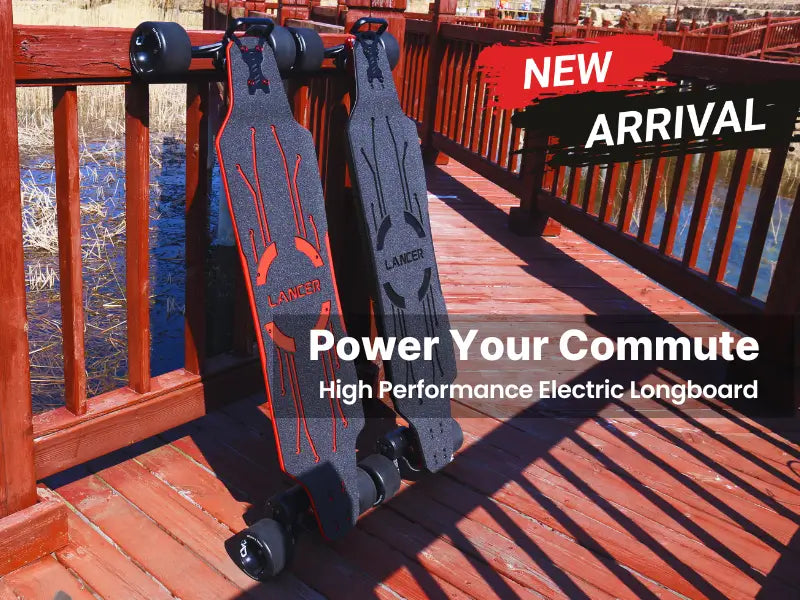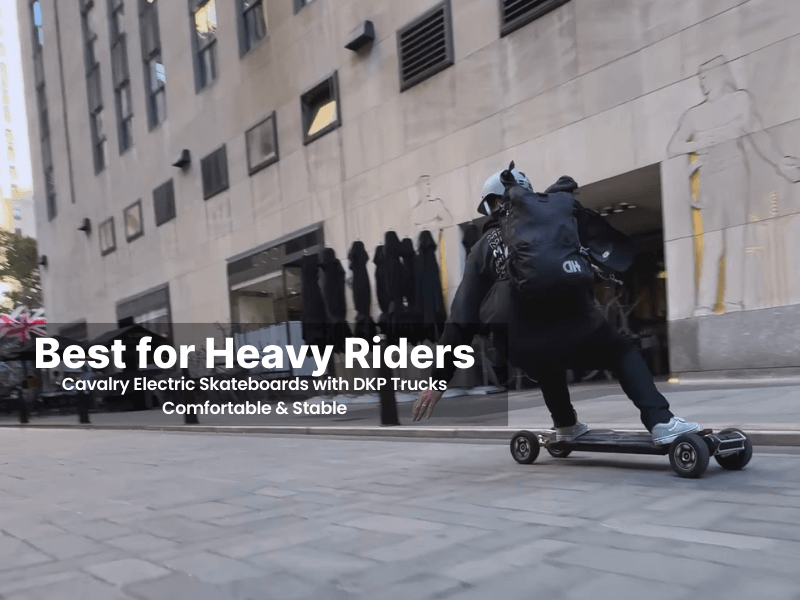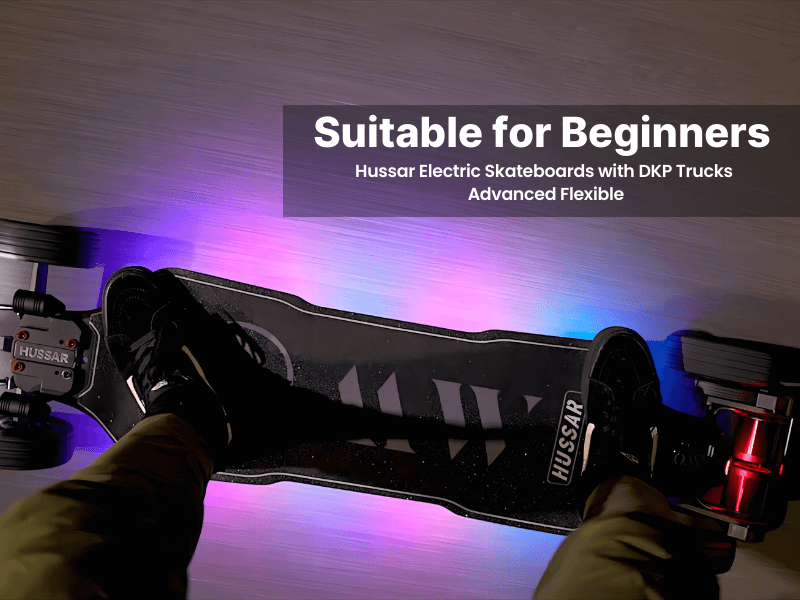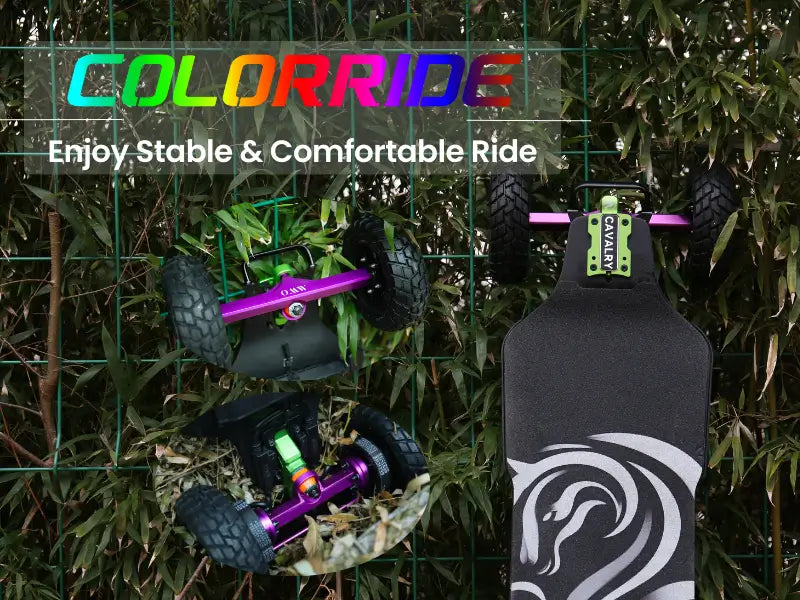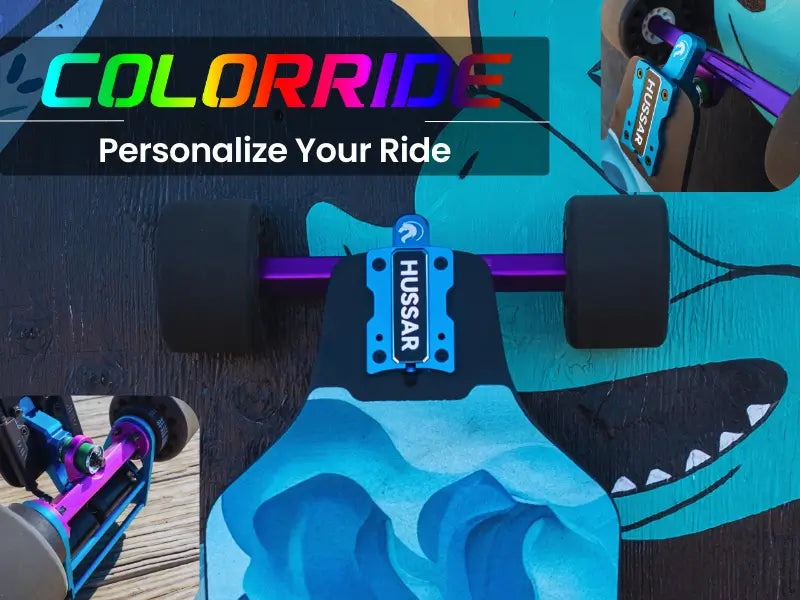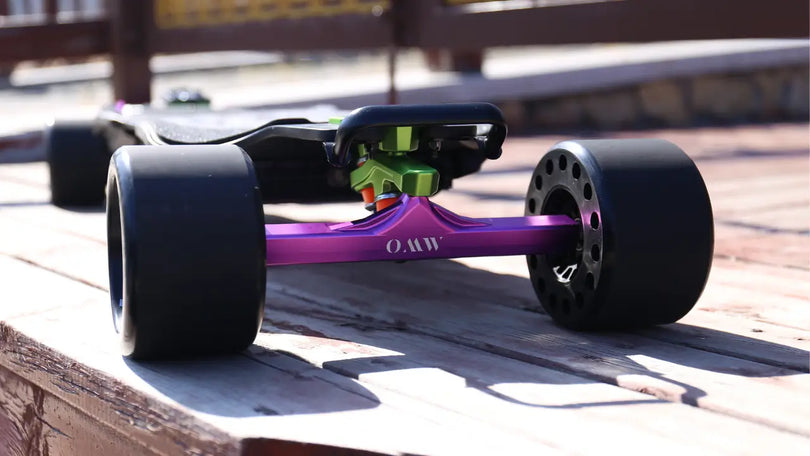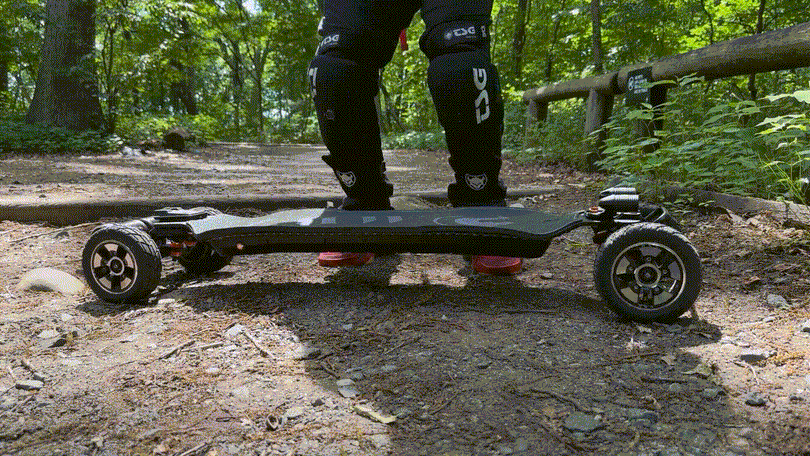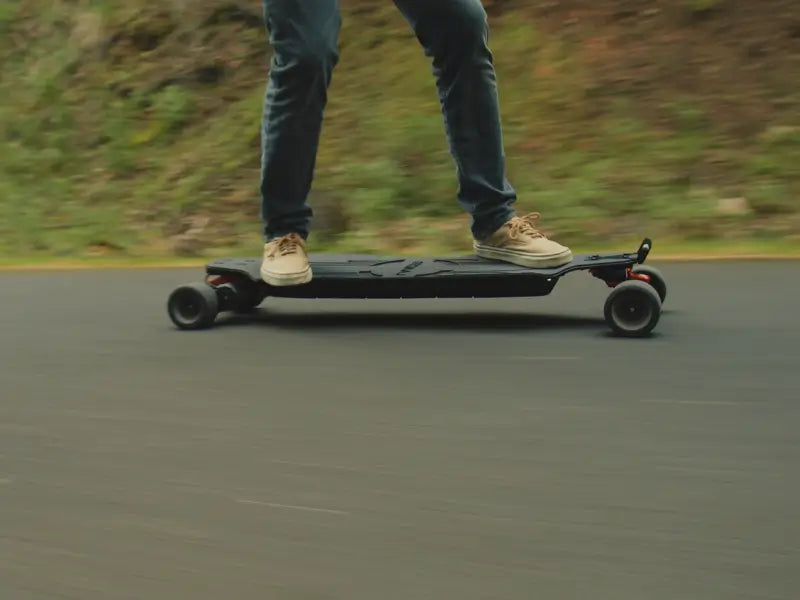Introduction: The Foundation of Your DIY Electric Skateboard Ride
Electric skateboard wheels are your crucial connection to the road, directly impacting speed, range, comfort, grip, and overall performance. For DIY enthusiasts, choosing the right wheels is paramount, as they can transform your ride, making it smoother, safer, and more enjoyable. Efficient wheels can even extend your battery's effective range, making them a performance multiplier for your entire build. This guide will help you navigate wheel selection and pick wheels that match your riding style.
 I. Key Considerations for Electric Skateboard Wheels: Size, Durometer & Wheel Types
I. Key Considerations for Electric Skateboard Wheels: Size, Durometer & Wheel Types
A. Wheel Size (Diameter)
- Smaller Wheels (70–85mm): Acceleration, Agility & Lightweight Design
Smaller wheels offer quicker acceleration thanks to their lower rotational mass, allowing the board to spin up faster. However, they also reach the motor’s top RPM sooner, which limits top speed. Their lighter weight contributes to a more agile and portable setup, but comes at the cost of comfort—riders will feel more road imperfections, especially on rougher surfaces.
√ Great for urban commuting, tight turns, and responsive carving.
- Medium Wheels (90–100mm): Balanced & Versatile
Wheels in the 90–100mm range strike a balance between acceleration, top speed, and ride comfort, making them a favorite among DIY builders. They offer enough diameter to roll over most urban obstacles while maintaining responsive handling.
√ Common sizes like 90mm and 97mm are widely used for their versatility across varied city terrain.
- Larger Wheels (100mm+): Speed, Comfort & Terrain Capability
Wheels over 100mm in diameter—including all-terrain and pneumatic types—offer higher top speeds due to their larger circumference, allowing the board to cover more ground per motor revolution. They excel in comfort, effortlessly rolling over cracks, debris, and rough surfaces while significantly absorbing road vibrations.
These wheels are ideal for poor pavement or off-road use, but come with trade-offs. Their added mass results in slower acceleration, and they demand more torque—especially at startup—potentially reducing efficiency or range if not matched with suitable motors (typically lower-kV).
√ Best for riders prioritizing comfort, long-range cruising, or commuting over uneven or challenging terrain.
 B. Wheel Hardness (Durometer)
B. Wheel Hardness (Durometer)
Durometer measures wheel hardness on the A scale (e.g., 72A, 90A). This affects grip, ride comfort, and rolling resistance.
|
Durometer |
Feel & Use Case |
|
Soft (72A–80A) |
More grip, quieter, absorbs vibration. Ideal for rough roads and wet surfaces. |
|
Medium (83A–87A) |
Balanced performance for most street setups. |
|
Hard (90A–101A) |
Fast rolling on smooth pavement, but transmits more vibration. Better for speed and durability. |
For example, MAD Wheelz V2 (72A durometer) offers plush grip and comfort for everyday urban riders who want a smooth, vibration-dampened ride—even on old pavement.
✅ Tip: Match your wheel hardness to your terrain—grippier for uneven roads, harder for speed on smooth surfaces.
C. Wheel Types (referring to structure, construction, and tread)
Beyond size and durometer, wheel type—referring to structure, construction, and tread—plays a pivotal role in how your electric skateboard handles different surfaces and environments.
There are three main types of wheels used in DIY electric skateboards:
Polyurethane (PU) Street Wheels: The most common choice for city and commuter boards.
-
Pros:
- Fast-rolling and energy-efficient
- Lightweight and low maintenance
- Durable on smooth surfaces
- Widely available in various sizes and hardness levels
-
Cons:
- Poor shock absorption on rough terrain
- Feels harsh on cracks, cobblestone, or gravel
Best For: Smooth pavement, sidewalks, skate parks, and agile urban riding, such as MAD Wheelz V2 (105mm, 72A) use a soft, high-rebound PU formula, offering excellent grip, comfort, and stability—perfect for daily city cruising and carving.
Pneumatic (Air-Filled) Rubber Tires: For riders demanding comfort and off-road capability.
-
Pros:
- Superior vibration damping and ride comfort
- Easily handles bumps, potholes, and uneven surfaces
- Reduces impact on electronics and internal components
-
Cons:
- Heavier and adds rolling resistance
- Requires maintenance (tire pressure, occasional flats)
- Slightly reduces range if not well-matched to motor output
Best For: Gravel, trails, grass, and rough or broken pavement
Example: OMW’s 7-inch Pneumatic Natural Rubber Tires offer over 50% real rubber, boosting puncture resistance and improving energy efficiency by up to 12% over standard off-road tires.
All-Terrain (AT) Hybrid Wheels: Blending street control with off-road confidence.
-
Pros:
- Smoothly transition between street and off-road
- Often compatible with standard belt-drive systems
-
Cons:
- Heavier than pure PU wheels
Best For: Mixed terrain—pavement, light trails, dirt paths
Example: OMW Hussar’s 150mm rubber Wheels are engineered for all-terrain carving, offering enhanced comfort without sacrificing street performance or e-board control.
 II. Wheels and Drivetrain: A Synergistic Relationship
II. Wheels and Drivetrain: A Synergistic Relationship
Choosing the right wheel goes hand-in-hand with understanding your drivetrain. Your motor system not only determines torque and speed characteristics, but it also affects what wheels you can use and how your board feels on the road. Each system offers distinct trade-offs:
Hub Motors – Sleek, Simple, Efficient
Hub motors are built directly into the wheels, offering a stealthy look, quiet operation, and low maintenance (no belts or gears). Their efficiency at cruising speeds makes them popular for commuters. However, the thinner urethane sleeves can result in a firmer, less forgiving ride, especially on rough surfaces. Torque is also limited compared to belt or gear systems.
Best for: Urban commuting, minimal maintenance, budget-friendly builds.
Belt Drive – Customizable Power & Comfort
Belt-drive systems deliver higher torque and strong braking, ideal for hill climbs, quick acceleration, and tuning. They support a wide range of PU and AT wheels, often with thicker urethane for better ride comfort. On the downside, they require more frequent belt tension checks and replacements, and are slightly less efficient due to friction.
Best for: Versatile setups, carving, uphill performance, and customizable builds.
Gear Drive – Sealed Strength for Extreme Use
Gear drives use enclosed metal gears to transfer power, offering robust torque, no belt slippage, and better protection against dirt and debris. They're especially favored for off-road or high-performance boards. While highly durable, gear drives are often louder, heavier, and limited in wheel compatibility due to proprietary interfaces.
Best for: Off-road riding, high-speed stability, low-maintenance, rugged setups.
Direct Drive – Smooth Power, Full PU Compatibility
Direct-drive motors are mounted beside the wheels and spin them directly—no belts, no gears, just quiet, fluid motion. They allow the use of full-size PU wheels, delivering a smoother and grippier ride than hubs. However, they are heavier, more exposed to impact, and offer less torque than belt or gear systems.
Best for: Quiet city cruising, comfort-focused builds, riders who want full PU compatibility without belts.
Performance Tip
Proper matching of your wheel size, motor KV rating, and ESC configuration is critical. This ensures the drivetrain delivers optimal speed, torque, and thermal efficiency without overloading components.
III. Optimizing Your Ride Experience: Beyond the Basics
Your choice of wheels and drivetrain is just the beginning. To truly elevate ride quality, comfort, and safety, you need to consider the full system—from vibration dampening to stability tuning.
Vibration Dampening
Effective vibration control not only improves comfort but also extends the lifespan of sensitive electronics like batteries and ESCs.
Softer PU wheels and pneumatic tires naturally absorb more road shock.
Deck flex, as seen in OMW Lancer’s carbon composite deck, helps absorb vibrations underfoot.
Upgrades like shock-absorbing foam grip tape, EVA foam padding, rubber isolation mounts, and enclosure gaskets help minimize vibrations transmitted to internal components.
Stability & Foot Control
Larger wheels provide a more stable feel at high speeds, while deck shape further affects control.
Concave profiles and footwells create natural foot-locking zones.
The combination of a well-designed deck and matching wheel geometry results in better cornering, less fatigue, and more rider confidence, especially during long rides or downhill tucks.
Preventing Wheel Bite
Wheel bite—when your wheels touch the underside of the deck during aggressive turns—can cause sudden, dangerous stops. Common prevention techniques include:
- Adding risers (e.g., 1/8" rubber pads)
- Using harder bushings (91A+)
- Tightening your trucks
- Choosing decks with pre-flared or cut wheel wells
 IV. OMW Boards Wheel Innovation: Elevating Your DIY Build
IV. OMW Boards Wheel Innovation: Elevating Your DIY Build
At OMW Boards, wheels are more than just components—they’re a cornerstone of performance and a gateway to customization. Every wheel in our lineup is purpose-built for seamless integration with OMW decks, trucks, and drivetrains, helping DIY builders unlock smoother rides, greater control, and hassle-free upgrades.
6" & 7" Pneumatic Rubber Tires – Conquer Real Terrain
OMW’s premium all-terrain wheels are crafted with over 50% natural rubber content, engineered to take on the roughest surfaces while preserving speed and comfort. Key advantages include:
- Outstanding puncture resistance and long-lasting durability
- Superior shock absorption on gravel, dirt, and uneven roads
- Low rolling resistance compound that increases energy efficiency by up to 12%, giving you longer range without sacrificing grip
- Confident performance both on- and off-road, making them ideal for riders who demand versatility
These tires aren’t just built tough—they’re engineered to transform your terrain experience.
System-Level Optimization
OMW designs all decks, trucks, mounts, and drivetrains with wheel integration in mind. Whether you’re installing street PU or pneumatic tires, you’ll benefit from:
- Proper clearance and wheel well compatibility
- Optimized torque delivery with lower-kV motors
- Straightforward, DIY-friendly installation
- With OMW’s wheel lineup, you're not just upgrading parts—you’re enhancing the entire system.
 IV. DIY Wheel Installation & Maintenance: Keeping Your Board in Top Shape
IV. DIY Wheel Installation & Maintenance: Keeping Your Board in Top Shape
Proper installation and regular maintenance are essential to ensure your electric skateboard performs safely and efficiently over time. Here's how to do it right:
Installation Tips
Ensure pulleys are perfectly aligned with the motor and wheel hub. Apply thread locker (e.g., Loctite) on mounting bolts to prevent them from loosening due to vibrations.
Press-fit bearings gently into wheels to avoid damage. Use bearing spacers between the inner bearings for smooth, consistent rolling and to reduce stress under load.
Routine Maintenance
- Cleaning: Regularly clean wheels and bearings to remove dust, dirt, and grit. Use a soft brush or cloth, and avoid using water directly unless you fully dry and re-lubricate the bearings afterward.
- Lubrication: Apply bearing oil or light grease to maintain free spin and prevent corrosion. Never lubricate dirty bearings—clean them first.
- Belt Tension (For Belt Drives): Check tension regularly. A proper belt should have ~1cm (0.4") of vertical flex. Too loose causes skipping; too tight causes premature wear.
⚠️ Common Wear Issues
- Flat Spots: Caused by hard braking or power slides—leads to vibration and instability.
- Chunking: When small pieces of urethane break off. Common on rough terrain or with low-durometer PU. Inspect regularly and replace if severe.
- Moisture Damage: Avoid riding in wet conditions. Water can damage bearings and seep into enclosures, risking ESC or battery failure.
✅ Pro Tip
Proactive maintenance not only extends the life of your wheels and drivetrain but also ensures a smoother, quieter, and safer ride, especially at high speeds.
Conclusion: Your Wheels, Your Ride, Your Adventure
Wheels are more than just components—they define your ride’s character. From speed and grip to comfort and control, the right wheel choice transforms your DIY electric skateboard from ordinary to exceptional.
By understanding size, durometer, type, and drivetrain compatibility, and by practicing proper installation and maintenance, you gain full control over your build's performance and personality.

